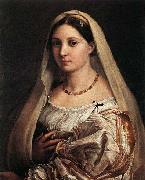|
|
|
|
|
RAFFAELLO Sanzio
|
|
Woman_with_a_Veil
|
|
|
|
|
|
|
|

|
|
Click to Enlarge
|
| RAFFAELLO_Sanzio
|
Woman with a Veil
new21/RAFFAELLO Sanzio-837396.jpg
|
|
|
|
|
|
| 1516 Oil on canvas, 82 x 60,5 cm Galleria Palatina (Palazzo Pitti), Florence Tradition identifies the subject with "la Fornarina", the woman whom the painter loved in his last years and whose face reappeared in both his paintings (e.g. in the Sistine Madonna) and those of his followers. However, the woman, has never been decisively identified. She seems to represent Raphael's ideal of beauty at this time. The painting shows greater attention to colour and to the rendering of skin and clothes in respect to previous female portraits. The regular oval of the young woman's face stands out against the dark background and her eyes hold an intense and penetrating look. The silk of her sleeves contrasts with her ivory-like skin, and is closely associated with the thin pleating of the dress, held up by a corset with golden embroidery. As in the portrait of Castiglione, the figure radiates a sense of great dignity and restraint. But greys and light-blues dominated the portrait of Castiglione: here the warm tonalities of white and gold take over. Raphael is preparing the wider colour range and the more complex composition which will be expressed in the Portrait of Leo X.Artist:RAFFAELLO Sanzio Title: Woman with a Veil (La Donna Velata) Painted in 1501-1550 , Italian - - painting : portrait |
|
|
Italian High Renaissance Painter, 1483-1520
Italian painter and architect. As a member of Perugino's workshop, he established his mastery by 17 and began receiving important commissions. In 1504 he moved to Florence, where he executed many of his famous Madonnas; his unity of composition and suppression of inessentials is evident in The Madonna of the Goldfinch (c. 1506). Though influenced by Leonardo da Vinci's chiaroscuro and sfumato, his figure types were his own creation, with round, gentle faces that reveal human sentiments raised to a sublime serenity. In 1508 he was summoned to Rome to decorate a suite of papal chambers in the Vatican. The frescoes in the Stanza della Segnatura are probably his greatest work; the most famous, The School of Athens (1510 C 11), is a complex and magnificently ordered allegory of secular knowledge showing Greek philosophers in an architectural setting. The Madonnas he painted in Rome show him turning away from his earlier work's serenity to emphasize movement and grandeur, partly under Michelangelo's High Renaissance influence. The Sistine Madonna (1513) shows the richness of colour and new boldness of compositional invention typical of his Roman period. He became the most important portraitist in Rome, designed 10 large tapestries to hang in the Sistine Chapel, designed a church and a chapel, assumed the direction of work on St. Peter's Basilica at the death of Donato Bramante,
|
|
|
|
|
|
|